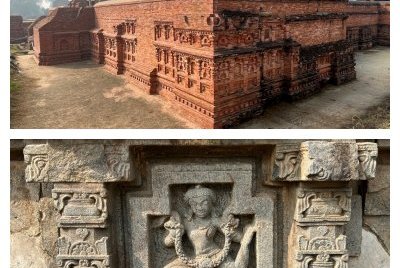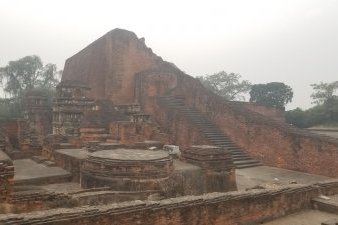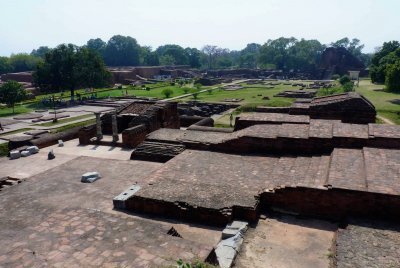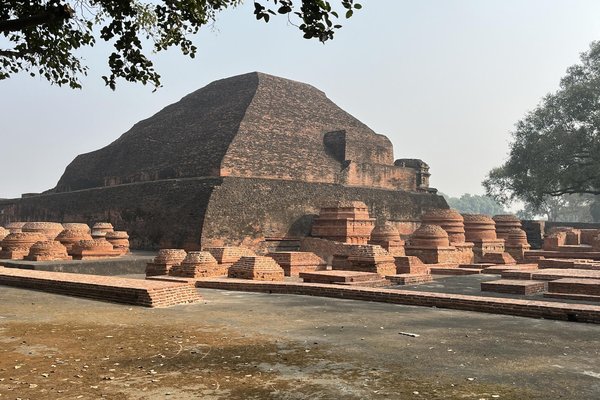India
Nalanda
The Archaeological Site of Nalanda Mahavihara at Nalanda, Bihar comprises the ruins of an early Buddhist monastic and educational center.
Apart from its religious buildings, the site contained 11 ‘viharas’ with a distinct, standardized architecture for study and housing. Nalanda was one of the most important places of learning in its day. It attracted scholars and students from near and far with some travelling from Tibet, China, Korea, and Central Asia.
Community Perspective: doable as a day trip from Bodh Gaya or Patna. Its history far exceeds what can be seen at the excavations: essentially “It's brick walls”. Bring your own notes as the site's interpretation and signage are minimal.
Site Info
Official Information
- Full Name
- Archaeological Site of Nalanda Mahavihara at Nalanda, Bihar (ID: 1502)
- Country
- India
- Status
-
Inscribed 2016
Site history
History of Nalanda
- 2018: Name change
- From "Archaeological Site of Nalanda Mahavihara (Nalanda University) at Nalanda, Bihar" to "Archaeological Site of Nalanda Mahavihara at Nalanda, Bihar"
- 2016: Advisory Body overruled
- ICOMOS proposed Deferral
- 2016: Inscribed
- Inscribed
- Type
- Cultural
- Criteria
- iv
- vi
Links
- UNESCO
- whc.unesco.org
- Official
-
- asi.nic.in — Archaeological Survey of India - Nalanda
All Links
UNESCO.org
- whc.unesco.org — whc.unesco.org/
Official Website
- asi.nic.in — Archaeological Survey of India - Nalanda
News Article
- June 26, 2016 telegraphindia.com — Nalanda blame game begins
- March 20, 2009 hindu.com — India seeks World Heritage Site status for Nalanda University
Community Information
- Community Category
- Archaeological site: South (East) Asian
Travel Information
Recent Connections
-
In Video Games
Civilization VII -
Already inscribed still on T List
Also included within TWHS "Sites along … -
Untranslated Toponyms
"Mahavihara" is the Sanskrit and Pali t…
Connections of Nalanda
- Individual People
-
-
Emperor Ashoka
consecrated the bodily remains of Sariputta in Nalanda's main stupa (AB ev) -
Xuanzang
visited Nalanda first in 637 and then again in 642, spending a total of around two years at the monastery (AB ev)See en.wikipedia.org
-
- Trivia
-
-
In Video Games
Civilization VII
-
- History
-
-
Silk Roads
(Near) Southern Land Route; in ICOMOS thematic study but no details on role or function
-
- Architecture
-
-
Brick architecture
Most of the constructions
-
- World Heritage Process
-
-
Already inscribed still on T List
Also included within TWHS "Sites along the Uttarapath, Badshahi Sadak, Sadak-e-Azam, Grand Trunk Road" (site 84)
-
- Religion and Belief
-
-
Stupa
principle stupa encased in a chaitya (stupachaitya) (AB ev) -
Buddhist sites in non-Buddhist countries
-
Religious Relics
"In Nalanda there is only one relic stupa which is the core of site no. 03. It was constructed by Emperor Ashoka in the 3rd century BC to consecrate the bodily remains of Sariputta." (AB ev)
-
- Timeline
-
-
Built in the 3rd century BC
a monastic-cum-scholastic institution dating from the 3rd century BC to the 13th century AD (AB ev)
-
- Science and Technology
- Visiting conditions
-
-
Foreigner prices
Citizens of India and visitors of SAARC (Bangladesh, Nepal, Bhutan, Sri Lanka, Pakistan, Maldives and Afghanistan) and BIMSTEC Countries (Bangladesh, Nepal, Bhutan, Sri Lanka, Thailand and Myanmar) - Rs.15 per head. Others: Rs. 200/- per headSee asi.nic.in
-
- WHS Names
-
-
Name changes
2018 -
Untranslated Toponyms
"Mahavihara" is the Sanskrit and Pali term for a great vihara (centre of learning or Buddhist monastery)See en.wikipedia.org
-
News
- telegraphindia.com 06/26/2016
- Nalanda blame game begins
- hindu.com 03/20/2009
- India seeks World Heritage Site st…
Recent Visitors
Visitors of Nalanda
- Alberto Rodriguez Gutierrez
- Alex Goh
- Atila Ege
- Bill Maurmann
- Chalamphol Therakul
- Chinmaya
- DouglasR
- Elis
- Els Slots
- Erik Jelinek
- fedemarch92
- Gernot
- Kurt Lauer
- Luke LOU
- Mahuhe
- marcel staron
- Mikko
- Miloš Tašković
- MMM
- Reza
- Roman Bruehwiler
- Sergio Arjona
- Solivagant
- Stanislaw Warwas
- Szucs Tamas
- Thomas Buechler
- Thomas van der Walt
- Tim Allen
- Waxwing
- Xiquinho Silva
- Zoë Sheng
Community Reviews
Show full reviews
I enjoyed Nalanda, probably because my expectations were low. We arrived just after 9 a.m. from Patna (2h by car on a good road, once you’ve managed your way out of the congested city center). I would suggest arriving this early as the site attracts larger numbers of daily visitors than you can imagine for an archaeological site in rural Bihar. It seems to be included in many of the group tours of the pilgrims visiting the Mahabodhi Temple, so there will be plenty of Asian groups around. Also, it’s a nicely landscaped park that attracts the locals from the nearby large city of Bihar Sharif.
The extent of the site surprised me the most. I had mostly seen pictures of Temple 3 beforehand, and as it is the most complete it will attract your attention immediately after entering the complex. But there are many more parts worth seeing, especially among the temples. The monasteries follow a specific mould and once you’ve seen one of those, it’s enough.
Interpretation and signage at the site are very minimal, and that doesn’t help finding the more interesting spots. You’ll easily miss a side path. At first, I was pleased to see that they added QR codes for more information next to each building, but after scanning it turned out that it contained the same text as painted on the stone panels.
A simple map plus useful explanations can be found here. Worth a closer look are:
- …

Most about this place has already been said in a greatly written review so I shall now only add that it has since been inscribed and got a nice price hike. Twice!
I arrived here by car from Patse and there were so many locals around, school groups, monks, selfie-posting teenagers, selfie-posting monks, a whole food market along University Road, I didn't expect to get through it all. However, there are actually parking spaces just past the entrance gate. So you pay that hefty entrance tickets for a bunch of walls. Mostly. There is one impressive building still standing tall but there is no way you would know this place was a big ancient university with monasteries and temples unless you read all signs. It's brick walls now. The area is not big. I figured this is all I can see and went through the loop within 30 minutes. Next up the museum and off we go again. Very disappointed. Makes me wonder what people expect to see here. Agree that the history behind it is important though, not agreeing that I should seek out the place to see it. The road from Patna is also very annoying and perhaps next time I would stay on the toll road longer.
Keep reading 0 comments
Nalanda epitomizes both what India has to offer in uninscribed sites and also its perennial inability to bring these forward to successful conclusion!! The Web is full of calls for it to be inscribed (often uninformed in suggesting that fault lies with UNESCO rather than with the governments of India and Bihar!). The most recent (early 2013) have been from the Nobel Laureates for Economics Amartya Sen and Joseph Stiglitz.
So what is so special? Well the ruins at Nalanda are of what is claimed to be the world’s first international residential university, with students coming from as far away as Tibet, China Greece, Persia, Korea, Japan and Java. It is claimed that, in its time, it was the most prestigious seat of learning in Asia. The Tang dynasty pilgrim Xuanzang left detailed descriptions of its size and magnificence. It operated between the 5th and 12th Centuries when it was sacked by Muslim invaders who burnt its libraries and destroyed its buildings. It accommodated over 10000 students and 2000 teachers across an enormous site. During excavations between 1915–37 and 1974–82 11 monasteries and 6 temples were uncovered across a sq km – but over 90% of the site is still thought to be unexcavated.
The structures are all in brick and reminded me of the Vihara in Pahapur Bangladesh (see my review) which is on a far smaller scale. The monasteries are all virtually identical in layout and consist of quadrangles of cells around a central …
Keep reading 0 comments
